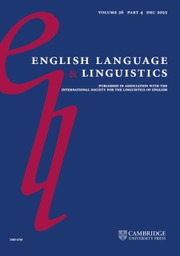No CrossRef data available.
Article contents
Emma Moore, Socio-syntax: Exploring the social life of grammar. Cambridge: Cambridge University Press, 2024. Pp. 256. ISBN 9781108843973.
Review products
Emma Moore, Socio-syntax: Exploring the social life of grammar. Cambridge: Cambridge University Press, 2024. Pp. 256. ISBN 9781108843973.
Published online by Cambridge University Press: 02 December 2024
Abstract
An abstract is not available for this content so a preview has been provided. Please use the Get access link above for information on how to access this content.

- Type
- Book Review
- Information
- Copyright
- Copyright © The Author(s), 2024. Published by Cambridge University Press
References
Bucholtz, Mary. 1999. ‘Why be normal?’ Language and identity practices in a community of nerd girls. Language in Society 28(2), 203–23.CrossRefGoogle Scholar
Bucholtz, Mary, Campbell, Eric W., Cevallos, Teresa, Cruz, Veronica, Fawcett, Alexia Z., Guerrero, Bethany, Lydon, Katie, Mendoza, Inî G., Peters, Simon L. & Basurto, Griselda Reyes. 2023. Researcher positionality in linguistics: Lessons from undergraduate experiences in community-centered collaborative research. Language and Linguistics Compass 17(4), https://doi.org/10.1111/lnc3.12495CrossRefGoogle Scholar
Charity Hudley, Anne H. & Mallison, Christine. 2018. Introduction: Language and social justice in higher education. Journal of English Linguistics 46(3), 175–85.CrossRefGoogle Scholar
Cheshire, Jenny. 1999. Taming the vernacular: Some repercussions for the study of syntactic variation and spoken grammar. Cuadernos de Filologia Inglesa 8, 59–80.Google Scholar
Cheshire, Jenny. 2003. Social dimensions of syntactic variation: The case of when clauses. In Britain, David & Cheshire, Jenny (eds.), Social dialectology: In honour of Peter Trudgill, 245–61. Amsterdam: John Benjamins.CrossRefGoogle Scholar
Dinkin, Aaron. 2016. Variant-centered variation and the like conspiracy. Linguistic Variation 16(2), 221–46.CrossRefGoogle Scholar
Eckert, Penelope. 1988. Adolescent social structure and the spread of linguistic change. Language in Society 17(2), 183–207.CrossRefGoogle Scholar
Eckert, Penelope. 2012. Three waves of variation study: The emergence of meaning in the study of sociolinguistic variation. Annual Review of Anthropology 41, 87–100.CrossRefGoogle Scholar
Labov, William. 1993. The unobservability of structure and its linguistic consequences. Paper presented at New Ways of Analyzing Variation (NWAV) 22, 22–25 October, Ottawa, ON, Canada.Google Scholar
Moore, Emma & Podesva, Robert. 2009. Style, indexicality, and the social meaning of tag questions. Language in Society 38, 447–85.CrossRefGoogle Scholar
Tagliamonte, Sali A. 2016. Making waves: The story of variationist sociolinguistics. Malden, MA, and Oxford: Wiley.Google Scholar



